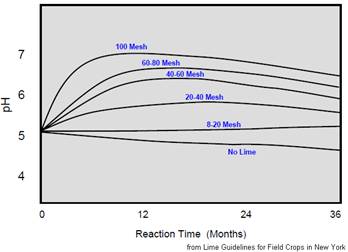Competency Area 5: Soil pH and Liming
PO 41. Describe how purity, fineness, and Calcium Carbonate Equivalent (CCE) affect the neutralizing ability of liming materials.
Calcium Carbonate Equivalent (CCE) is the neutralizing value of a liming material compared to pure calcium carbonate. A CCE of 100% indicates that a material will neutralize the same amount of acidity per pound as pure calcium carbonate.
Fineness is related to how small the lime particles are. The finer a limestone is ground, the faster it will react in the soil. Fineness is reported as a particle size distribution usually as the percentage of the material that will pass 20, 60, and 100-mesh screens. An example of the size distribution for a typical good-quality limestone is: 95% passing 20 mesh; 60% passing 60 mesh; 50% passing 100 mesh. A distribution such as the one above is a good compromise between cost and practical agronomic effectiveness. Material larger than 20 mesh reacts too slow to be of much value as a liming material. All very fine, less than 100 mesh material will react quickly but it will be much more expensive and may be difficult to handle. Fineness does not increase the total neutralizing value of a limestone, just how fast it will react.

Effective Neutralizing Value (ENV) or Effective CEE (ECCE) allows comparison of different liming materials, determined by the CCE x particle size distribution expressed as fineness. Limestones react at rates proportional to the surface area of the particles, and the surface area of the particles is related to the size of the lime particle. The CCE portion of the lime will react.
- 100% of lime that passes 100 mesh screen will react in 1 year
- 80% of lime that passes 60 but is held on 100 mesh will react in 1 year
- 40% of lime that passes 20 but is held on 60 mesh will react in 1 year
To determine the ENV:
- Subtract the % passing 60 mesh from the % passing 20 mesh, multiply by 0.40
- Subtract the % passing 100 mesh from the % passing 60 mesh, multiply by 0.80
- Multiply the % passing 100 mesh by 1.00
- Add the above three numbers to obtain the fineness factor (should be less than 100)
- Multiply the above number by the CCE in decimal form to get the ENV
- The ENV should be between about 30 and 100 for pulverized limestones sold in NY
Example:
The cost per ton of 100% ENV represents the cost for the quantity of material that will react with the soil in the first year, and allows cost comparison with other liming materials.
Soil test recommendations are based on limestone quality. Therefore, the recommendation must be adjusted for the quality of the limestone to be used. PA guidelines are based on CCE and fineness; NY guidelines are based on ENV.
Quick Links
- Competency Area 1: Basic Concepts of Plant Nutrition
- Competency Area 2: Basic Concepts of Soil Fertility
- Competency Area 3: Soil Testing and Plant Tissue Analysis
- Competency Area 4: Nutrient Sources, Analyses, Application Methods
- Competency Area 5: Soil pH and Liming
- Competency Area 6: Nutrient Management and Planning
